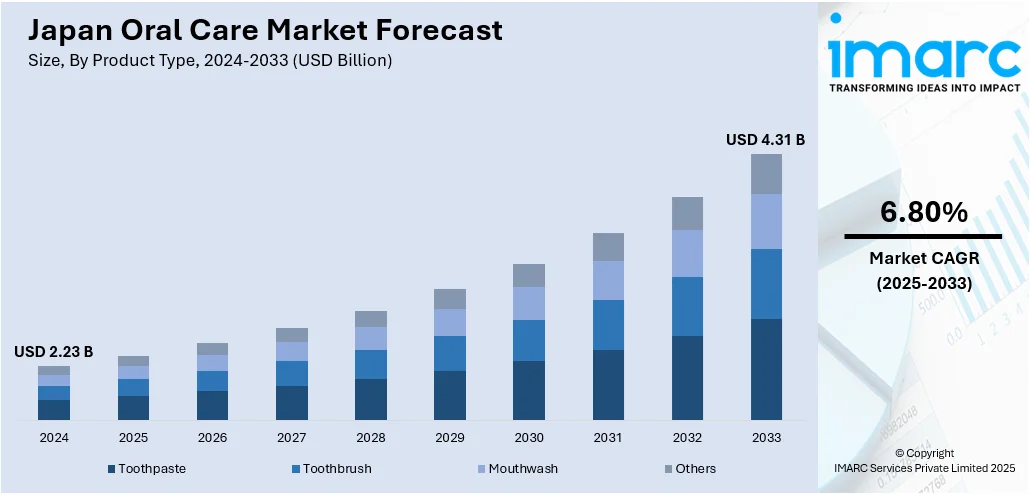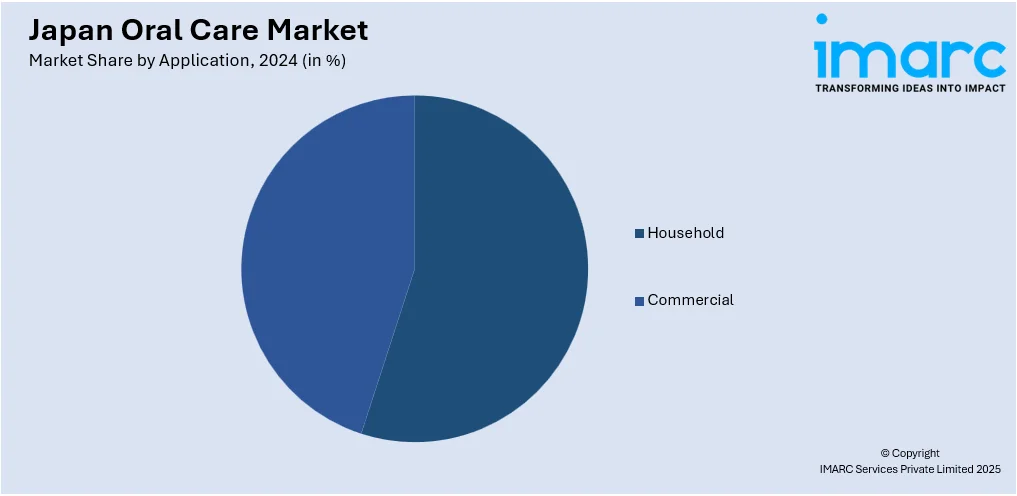
Japan Oral Care Market Size, Share, Trends and Forecast by Product Type, Application, Distribution Channel, and Region, 2025-2033
Japan Oral Care Market Overview:
The Japan Oral Care Market size reached USD 2.23 Billion in 2024. Looking forward, IMARC Group expects the market to reach USD 4.31 Billion by 2033, exhibiting a growth rate (CAGR) of 6.80% during 2025-2033. The market is driven by rising prevalence of aging population with a desire to maintain dental health, government-sponsored healthcare programs and widespread dental insurance coverage. Advances in digital dentistry and growing popularity of cosmetics also propel the market growth. Quality, technologically superior dental care products that are popular among urban consumers are further increasing the Japan oral care market share.
|
Report Attribute
|
Key Statistics
|
|---|---|
|
Base Year
|
2024 |
|
Forecast Years
|
2025-2033
|
|
Historical Years
|
2019-2024
|
| Market Size in 2024 | USD 2.23 Billion |
| Market Forecast in 2033 | USD 4.31 Billion |
| Market Growth Rate 2025-2033 | 6.80% |
Japan Oral Care Market Trends:
Emphasis on Preventive and Cosmetic Dentistry
There is increased movement toward cosmetic and preventive dentistry in Japan, supported by a fast-growing ageing population and increased awareness about health. The trend is supported by the government in the form of subsidized dental treatment schemes and public health initiatives, ensuring dental treatment at lower costs and encouraging frequent check-ups. Increased insurance coverage, particularly for advanced and preventive care, reduces the financial burden of patients, promoting increased utilization of dental services. Additionally, the growth of dental clinics, especially in urban areas, boosts service accessibility and competition, thereby improving the quality of service. This focus on preventive care provides for proper oral health and reduces long-term treatment costs, thereby encouraging the overall growth of the entire dental care market.

To get more information on this market, Request Sample
Technological Advances in Dental Care
Japan's dental care market is developing through the incorporation of advanced digital technologies. The addition of artificial intelligence (AI) in diagnostic equipment and treatment planning enhances the capability of dental professionals for more accurate and personalized care. Tele-dentistry makes remote consultation, diagnosis, and follow-up possible, enhancing the access to dental care, especially in rural populations. Dental education and patient consultation are being transformed by virtual reality (VR) and augmented reality (AR) technologies. These technologies enhance dental students' instruction through immersive simulation and help patients better understand their treatment procedures through visual simulation. These technologies improve the speed and accuracy of dental procedures along with the patient experience, further driving the Japan oral care market growth.
Cultural Influence on Oral Health Practices
Cultural factors play a major role in defining oral health behavior in Japan. The historically low-sugar and high-fiber diet of Japanese cuisine assists in enhancing oral health results. There is also a strong cultural value placed on looks and aesthetics, which contributes to the high demand for cosmetic dental treatments like tooth whitening and orthodontics. The routine of brushing teeth daily is deeply rooted in Japanese culture, with everyone brushing after meals and before bed. Government policy and public health initiatives, combined with this cultural focus on mouth hygiene, have helped to improve the oral health of the population. Additionally, the demographic demand of an aging population for restorative dental services further fuels market demand, emphasizing the significance of culturally informed oral health habits in defining Japan's dental care landscape.
Japan Oral Care Market Segmentation:
IMARC Group provides an analysis of the key trends in each segment of the market, along with forecasts at the country and regional levels for 2025-2033. Our report has categorized the market based on product type, application, and distribution channel.
Product Type Insights:
- Toothpaste
- Toothbrush
- Mouthwash
- Others
A detailed breakup and analysis of the market based on the product type has also been provided in the report. This includes toothpaste, toothbrush, mouthwash, and others.
Application Insights:

- Household
- Commercial
A detailed breakup and analysis of the market based on the application has also been provided in the report. This includes household and commercial.
Distribution Channel Insights:
- Hypermarkets and Supermarkets
- Convenience Stores
- Online Sales Channels
- Others
The report has provided a detailed breakup and analysis of the market based on the distribution channel. This includes hypermarkets and supermarkets, convenience stores, online sales channels, and others.
Regional Insights:
- Kanto Region
- Kansai/Kinki Region
- Central /Chubu Region
- Kyushu-Okinawa Region
- Tohoku Region
- Chugoku Region
- Hokkaido Region
- Shikoku Region
The report has also provided a comprehensive analysis of all the major regional markets, which include Kanto Region, Kansai/Kinki Region, Central /Chubu Region, Kyushu-Okinawa Region, Tohoku Region, Chugoku Region, Hokkaido Region, and Shikoku Region.
Competitive Landscape:
The market research report has also provided a comprehensive analysis of the competitive landscape. Competitive analysis such as market structure, key player positioning, top winning strategies, competitive dashboard, and company evaluation quadrant has been covered in the report. Also, detailed profiles of all major companies have been provided.
Japan Oral Care Market News:
- In April 2025, innovative Japanese research team, created a medication aimed at regenerating a third set of human teeth, a revolutionary advancement that may significantly transform global dental care. The novel medication, dubbed TRG-035, aims at and deactivates the USAG-1 protein, enabling those inactive tooth buds to become active again. Created by Dr. Katsu Takahashi and his team alongside Kyoto University, this therapy is administered through an intravenous injection. It has demonstrated remarkable outcomes in animal studies, as mice and ferrets effectively developed new, completely functional teeth without negative consequences.
- In June 2024, an initiative to increase dental health awareness was launched by Fujitsu Japan Limited and Kamoenai Village in Hokkaido. The two organizations used Fujitsu Preventive Dentistry Cloud Service to demonstrate a preventive dentistry approach during an oral checkup for about 40 kids at a school on June 27 and 28, 2024. With the Fujitsu Preventive Dentistry Cloud Service, students and their parents may use their smartphones to monitor their progress and determine their risk of tooth decay. This allows for proactive measures and develops individual auditory consciousness.
Japan Oral Care Market Report Coverage:
| Report Features | Details |
|---|---|
| Base Year of the Analysis | 2024 |
| Historical Period | 2019-2024 |
| Forecast Period | 2025-2033 |
| Units | Billion USD |
| Scope of the Report |
Exploration of Historical Trends and Market Outlook, Industry Catalysts and Challenges, Segment-Wise Historical and Future Market Assessment:
|
| Product Types Covered | Toothpaste, Toothbrush, Mouthwash, Others |
| Applications Covered | Household, Commercial |
| Distribution Channels Covered | Hypermarkets and Supermarkets, Convenience Stores, Online Sales Channel, Others |
| Regions Covered | Kanto Region, Kansai/Kinki Region, Central /Chubu Region, Kyushu-Okinawa Region, Tohoku Region, Chugoku Region, Hokkaido Region, Shikoku Region |
| Customization Scope | 10% Free Customization |
| Post-Sale Analyst Support | 10-12 Weeks |
| Delivery Format | PDF and Excel through Email (We can also provide the editable version of the report in PPT/Word format on special request) |
Key Questions Answered in This Report:
- How has the Japan oral care market performed so far and how will it perform in the coming years?
- What is the breakup of the Japan oral care market on the basis of product type?
- What is the breakup of the Japan oral care market on the basis of application?
- What is the breakup of the Japan oral care market on the basis of distribution channel?
- What is the breakup of the Japan oral care market on the basis of region?
- What are the various stages in the value chain of the Japan oral care market?
- What are the key driving factors and challenges in the Japan oral care market?
- What is the structure of the Japan oral care market and who are the key players?
- What is the degree of competition in the Japan oral care market?
Key Benefits for Stakeholders:
- IMARC’s industry report offers a comprehensive quantitative analysis of various market segments, historical and current market trends, market forecasts, and dynamics of the Japan oral care market from 2019-2033.
- The research report provides the latest information on the market drivers, challenges, and opportunities in the Japan oral care market.
- Porter's five forces analysis assist stakeholders in assessing the impact of new entrants, competitive rivalry, supplier power, buyer power, and the threat of substitution. It helps stakeholders to analyze the level of competition within the Japan oral care industry and its attractiveness.
- Competitive landscape allows stakeholders to understand their competitive environment and provides an insight into the current positions of key players in the market.
Need more help?
- Speak to our experienced analysts for insights on the current market scenarios.
- Include additional segments and countries to customize the report as per your requirement.
- Gain an unparalleled competitive advantage in your domain by understanding how to utilize the report and positively impacting your operations and revenue.
- For further assistance, please connect with our analysts.
 Request Customization
Request Customization
 Speak to an Analyst
Speak to an Analyst
 Request Brochure
Request Brochure
 Inquire Before Buying
Inquire Before Buying




.webp)




.webp)












